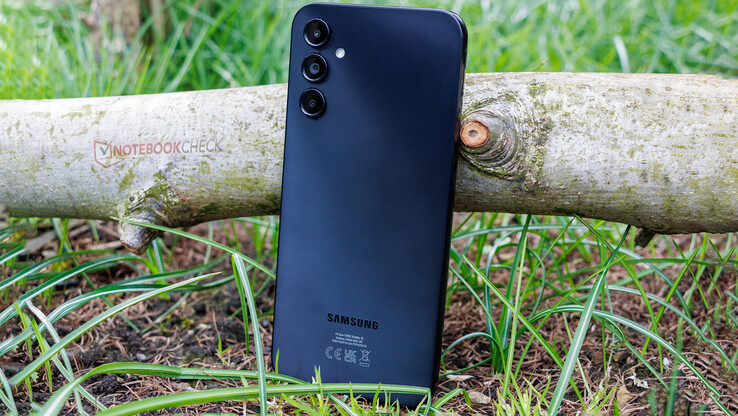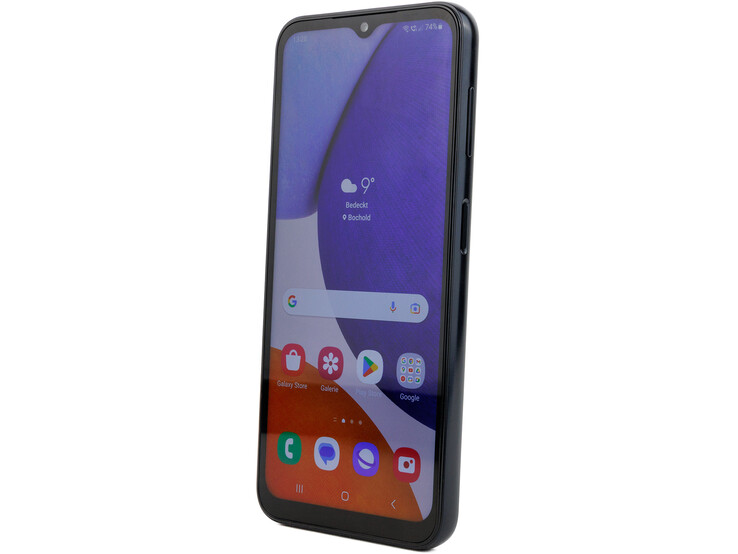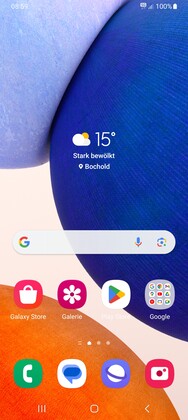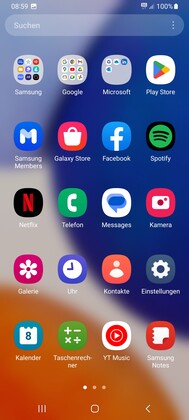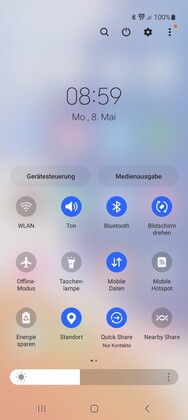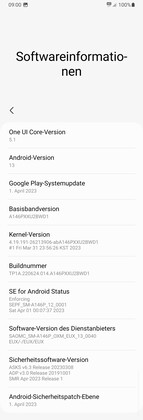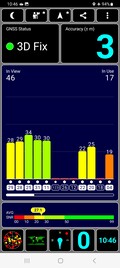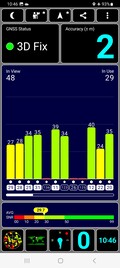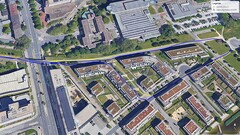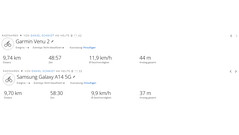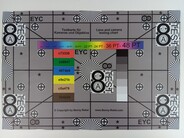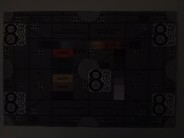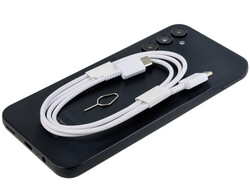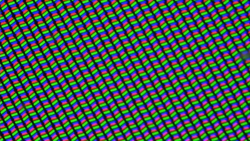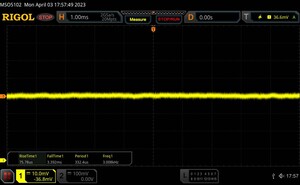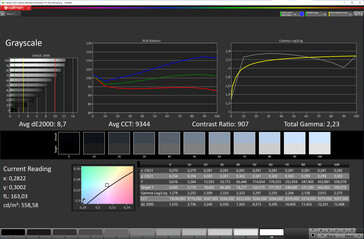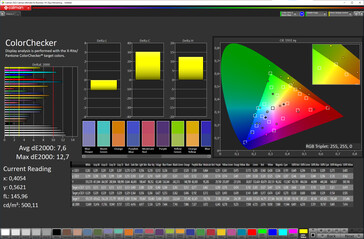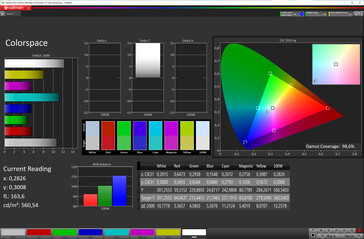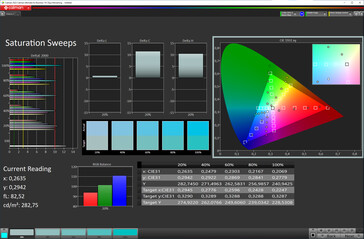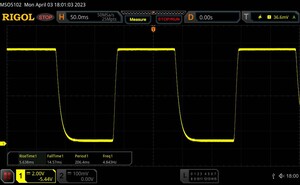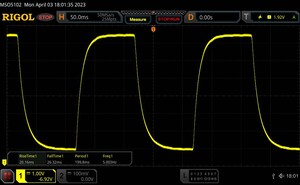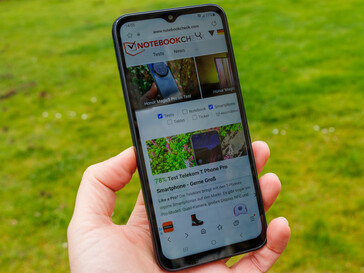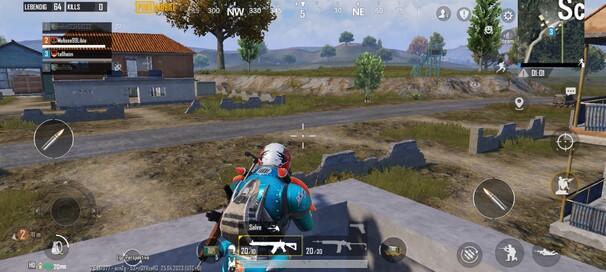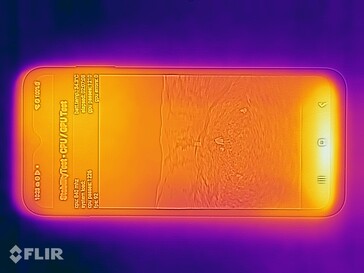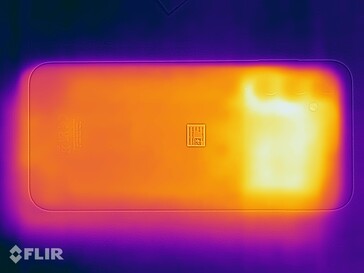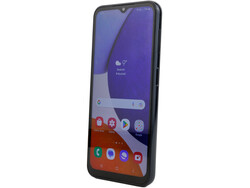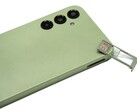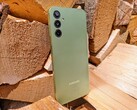Samsung Galaxy A14 5G review - A pepped up introductory smartphone for a low price
The Samsung Galaxy A14 5G is an introductory smartphone and direct successor to the Galaxy A13 5G. It is available in two storage versions: 64 GB and 128 GB. The version with 64 GB costs $199.99 - making it around $10 more than its predecessor.
While reviewing the A13 5G, we critiqued its slow memory, lack of a wide-angle lens and low resolution. Its charging times, speakers and its location accuracy were also sub-par. Many of these issues have been improved with the release of the Samsung Galaxy A14 5G. After all, this smartphone is one of the Korean manufacturer's most sold and the version with LTE was actually the 4th most sold in the world last year (we reported).
possible competitors compared
Rating | Date | Model | Weight | Drive | Size | Resolution | Price |
|---|---|---|---|---|---|---|---|
| 79.4 % v7 (old) | 05 / 2023 | Samsung Galaxy A14 5G Dimensity 700, Mali-G57 MP2 | 202 g | 64 GB UFS 2.2 Flash | 6.60" | 2408x1080 | |
| 78.3 % v7 (old) | 04 / 2023 | Telekom T Phone Dimensity 700, Mali-G57 MP2 | 195 g | 64 GB UFS 2.0 Flash | 6.52" | 1600x720 | |
| 81.4 % v7 (old) | 05 / 2023 | Xiaomi Poco X5 SD 695 5G, Adreno 619 | 190 g | 128 GB UFS 2.2 Flash | 6.67" | 2400x1080 | |
| 78.5 % v7 (old) | 07 / 2022 | Honor X8 SD 680, Adreno 610 | 177 g | 128 GB UFS 2.1 Flash | 6.70" | 2388x1080 | |
| 80.2 % v7 (old) | 07 / 2021 | Nokia X10 SD 480, Adreno 619 | 220 g | 64 GB UFS 2.1 Flash | 6.67" | 2400x1080 |
Case - grooved plastic
The Samsung Galaxy A14 5G comes in black, silver and green - the former being our test device. Its design is reminiscent of its predecessor - although this time, Samsung haven't gone for a plastic unibody. Now, its design is closer to that of its big sister, the Galaxy A34, or rather the A54. However, its frame and back case continue to be made of plastic - and Samsung haven't given any further details about what type of glass is used for the front.
The grooved back of the case makes for an unusual feel and gives you a slightly better grip on the phone. If you drag your fingernails across it, it makes quite an annoying noise. Fingerprints are still somewhat visible on the surface. The display-to-surface ratio is okay - it does, however, feel a little outdated. The same can be said for the plastic frame surrounding the screen. Although, it is made well: Everything lines up perfectly - apart from a slight gap where the card slot meets the phone's frame. Trying to bend the frame doesn't lead to any crackling noises - in order to cause a subtle wavy pattern to appear on the LCD screen, you do have to press quite hard. Weighing in at 202 grams, the smartphone is a bit on the heavier side.
The A14 5G doesn't have any special protection against dust or water and the battery is built into the case. In terms of sustainability, Samsung could have tried a little harder - the device comes with plastic wrapped around its frame, and then the whole phone is wrapped in another sheet of transparent plastic.
Connectivity - the Galaxy A14 5G has a fast microSD slot
With regard to the phone's connectivity options, Samsung have not changed much since its predecessor. Its USB 2.0 port is as expected for this price range and it supports OTG, meaning peripheral devices or storage devices can be connected. In our test, it delivered average transmission rates of 31.62 MB/s.
Furthermore, the smartphone features Bluetooth 5.2, NFC and an audio jack. Another positive is that Samsung have continued to use a Dual SIM solution with additional space for a microSD card.
microSD card reader
In our test, the Galaxy A13 5G's microSD card slot was unfortunately still one of the slower models. Samsung have addressed this issue in the Galaxy A14 5G - here, its speed is two and a half times faster and delivers good transmission rates.
| SD Card Reader - average JPG Copy Test (av. of 3 runs) | |
| Samsung Galaxy A14 5G (Angelbird AV Pro V60) | |
| Xiaomi Poco X5 (Angelbird AV Pro V60) | |
| Telekom T Phone (Angelbird AV Pro V60) | |
| Nokia X10 (Angelbird V60) | |
| Samsung Galaxy A13 5G (Angelbird V60) | |
Cross Platform Disk Test (CPDT)
Software - the Samsung smartphone with 2 + 4 year updates
The Samsung Galaxy A14 5G comes with Google Android 13 and One UI 5.0 preinstalled, which already received an update to the current version (5.1) during the course of our test. Samsung have promised two further large system updates - meaning up to Android 15 - as well as two further years of security patches (from release date).
Compared to other more powerful smartphones, the assistant Bixby is no longer on board. In contrast, the Galaxy Store and a few more Samsung apps come preinstalled. Third-party apps from Microsoft, Meta, Netflix and Spotify also come with the phone - but, with the exception of OneDrive - you are able to uninstall them all if you don't need them. Microsoft's cloud service can only be deactivated and not uninstalled.
Communication and GNSS - 5G, Wi-Fi 5 and decent location tracking
The Samsung Galaxy A14 5G supports - as the name suggests - all current mobile communication standards, including 5G-Sub6. Its frequency cover is wide, which means you shouldn't have any problems connecting to the internet outside of the country. During our test, its reception properties in bigger cities didn't flag up any issues.
The WLAN receiver supports Wi-Fi 5, which means it can use 2.4 as well as 5.0 GHz networks. Together with our reference router, the Asus ROG Rapture GT-AXE11000, the device delivered acceptable data transfer rates which remained stable at all times.
| Networking | |
| iperf3 receive AXE11000 | |
| Average of class Smartphone (52 - 1857, n=181, last 2 years) | |
| Telekom T Phone | |
| Samsung Galaxy A14 5G | |
| Xiaomi Poco X5 | |
| Samsung Galaxy A13 5G | |
| Honor X8 | |
| iperf3 transmit AXE11000 | |
| Average of class Smartphone (49.8 - 1828, n=181, last 2 years) | |
| Telekom T Phone | |
| Samsung Galaxy A14 5G | |
| Samsung Galaxy A13 5G | |
| Xiaomi Poco X5 | |
| Honor X8 | |
| iperf3 transmit AX12 | |
| Nokia X10 | |
| iperf3 receive AX12 | |
| Nokia X10 | |
Although the Samsung Galaxy A14 5G only uses Single-Band-GNSS for its location tracking, its position can be quickly determined - even in buildings.
On a bike trip, the phone can be compared to the Garmin Venu 2. Deviations along a ten-kilometre-long route were minimal. The circle around the lake was also quite accurately traced - in between houses, the smartphone was a little inaccurate, but for navigation tasks this is still perfectly sufficient.
Phone functions and call quality
Fundamental features such as VoLTE and WLAN calls are supported by the Galaxy A14 5G, however, system-integrated SIP account management is not present.
Call quality when you hold the smartphone to your ear is fine - sometimes, there is a little bit of background noise. Its noise suppression manages to suppress quieter noise disturbances, but in louder settings, this feature quickly meets its limits. In loudspeaker mode, voices echo a little bit and the sound is sometimes a bit hollow.
Cameras - 50 MPix on the Galaxy A14 5G
The Galaxy A14 5G's front-facing camera has received an upgrade and now has a resolution of 13 MPix - the A13 5G had 5 MPix. Pictures taken using this camera look light and well-lit - but some details are still lacking despite its higher resolution. Portrait mode manages an appealing bokeh, however, the border between foreground and background is a little harsh.
Again, the main camera on the back of the device has three lenses and is pretty identical to that of its predecessor. It can take pictures in 4:3, 16:9, 1:1 and full format (20.1:9). The camera still doesn't have an ultra-wide angle lens and the two additional lenses don't really add any value to the device. The 50 MPix sensor delivers decent photos with a well-balanced composition. At times, the pixel binning technology doesn't quite manage to retain all the details in a photo - and at low light, the picture quality is somewhat disappointing. The camera doesn't have optical image stabilization and image enlargement is limited to a 10x digital zoom, which also delivers poor results.
On both sides, video can be recorded at a maximum quality of Full HD and at 30 fps. Unfortunately, there is no video stabilization option.
Image comparison
Choose a scene and navigate within the first image. One click changes the position on touchscreens. One click on the zoomed-in image opens the original in a new window. The first image shows the scaled photograph of the test device.
Main cameraMain camera5x zoomLow lightIn controlled lighting conditions, the Galaxy A14 5G displayed our test chart very accurately in the middle of the picture - toward the corners, a few aberrations can be seen at maximum resolution.
Its color reproduction is decent - dark green sometimes appears a little too light, whereas orange and cyan are sometimes a bit dark.
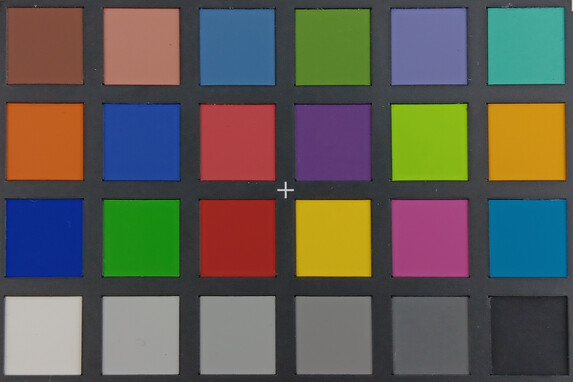
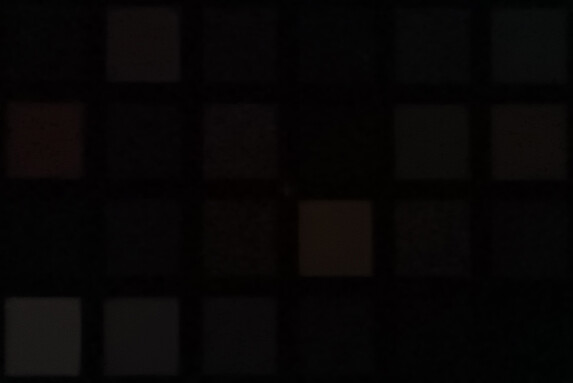
Accessories and warranty - small scope of delivery
The Samsung Galaxy A14 5G only comes with a USB-C cable as well as a small tool to open the card slot. A power adapter has to be acquired separately.
The phone comes with a 24-month warranty, which can be extended with Samsung Care+. This is an insurance package which runs for either one or two years and can optionally also cover theft. The costs range anywhere between $26 and $64 depending on the length and what is included - it is also limited to covering up to two claims per year. If it comes to this, you also have to pay around $27 in excess (around $54 in the case of theft).
Input devices & operation - A14 5G with fingerprint scanner built into the power button
The phone's capacitive touchscreen recognizes up to ten inputs at once and has good slide characteristics. Touch inputs are implemented precisely.
For biometric security purposes, the power button comes with a fingerprint scanner installed. This works quite reliably but isn't necessarily the fastest. Alternatively, you can set up face scanning via the front-facing camera, which is less secure and not very reliable in dim lighting conditions.
Compared to more expensive Samsung smartphones, this phone's power button doesn't come with Bixby preinstalled - instead, it just has a regular power-off menu. In the phone's settings, you can enable a double-click function. Its vibration is strong, but a bit fuzzy.
Display - Light 90 Hz PLS panel
The Galaxy A14 5G's display is larger than that of its predecessor and now has a diagonal measurement of 6.6 inches (16.76 cm), a resolution of 2,408 x 1,080 pixels and a refresh rate of 60 or 90 Hz. HDR is not supported.
However, this is not surprising in view of the display's brightness, which has a maximum of 573 cd/m² with the ambient light sensor enabled and is also on a similar level in the APL18 measurement (568 cd/m²) or with manual control (579 cd/m²)
Its black value is slightly higher, but this is compensated by the PLS panel's decent brightness, so the contrasts are still crisp.
| |||||||||||||||||||||||||
Brightness Distribution: 87 %
Center on Battery: 579 cd/m²
Contrast: 1016:1 (Black: 0.57 cd/m²)
ΔE ColorChecker Calman: 7.6 | ∀{0.5-29.43 Ø4.78}
ΔE Greyscale Calman: 8.7 | ∀{0.09-98 Ø5}
98.6% sRGB (Calman 2D)
Gamma: 2.23
CCT: 9344 K
| Samsung Galaxy A14 5G PLS LCD, 2408x1080, 6.6" | Telekom T Phone IPS, 1600x720, 6.5" | Xiaomi Poco X5 AMOLED, 2400x1080, 6.7" | Honor X8 TFT-LCD, 2388x1080, 6.7" | Nokia X10 IPS, 2400x1080, 6.7" | Samsung Galaxy A13 5G PLS, 1600x720, 6.5" | |
|---|---|---|---|---|---|---|
| Screen | 9% | 44% | 7% | 16% | 18% | |
| Brightness middle (cd/m²) | 579 | 419 -28% | 674 16% | 510 -12% | 674 16% | 471 -19% |
| Brightness (cd/m²) | 543 | 391 -28% | 683 26% | 469 -14% | 630 16% | 437 -20% |
| Brightness Distribution (%) | 87 | 89 2% | 98 13% | 78 -10% | 83 -5% | 86 -1% |
| Black Level * (cd/m²) | 0.57 | 0.29 49% | 0.82 -44% | 0.78 -37% | 0.31 46% | |
| Contrast (:1) | 1016 | 1445 42% | 622 -39% | 864 -15% | 1519 50% | |
| Colorchecker dE 2000 * | 7.6 | 6.1 20% | 1.6 79% | 2.5 67% | 3.39 55% | 5.43 29% |
| Colorchecker dE 2000 max. * | 12.7 | 11.9 6% | 5.3 58% | 5.8 54% | 6.95 45% | 10.55 17% |
| Greyscale dE 2000 * | 8.7 | 7.8 10% | 2.5 71% | 4.1 53% | 4.4 49% | 5.1 41% |
| Gamma | 2.23 99% | 2.21 100% | 2.21 100% | 2.45 90% | 2.175 101% | 2.12 104% |
| CCT | 9344 70% | 8208 79% | 6346 102% | 6307 103% | 8301 78% | 7465 87% |
* ... smaller is better
Screen Flickering / PWM (Pulse-Width Modulation)
| Screen flickering / PWM not detected | |||
In comparison: 53 % of all tested devices do not use PWM to dim the display. If PWM was detected, an average of 8111 (minimum: 5 - maximum: 343500) Hz was measured. | |||
Samsung don't offer any option to control the color representation on the device's LCD screen. The Galaxy A14 5G's display is calibrated to be quite cool and it depicts its colors as very saturated. This shouldn't be an issue in everyday use, but it is not possible to display colors naturally.
Display Response Times
| ↔ Response Time Black to White | ||
|---|---|---|
| 20.21 ms ... rise ↗ and fall ↘ combined | ↗ 5.638 ms rise | |
| ↘ 14.57 ms fall | ||
| The screen shows good response rates in our tests, but may be too slow for competitive gamers. In comparison, all tested devices range from 0.1 (minimum) to 240 (maximum) ms. » 44 % of all devices are better. This means that the measured response time is similar to the average of all tested devices (20.2 ms). | ||
| ↔ Response Time 50% Grey to 80% Grey | ||
| 46.48 ms ... rise ↗ and fall ↘ combined | ↗ 20.16 ms rise | |
| ↘ 26.32 ms fall | ||
| The screen shows slow response rates in our tests and will be unsatisfactory for gamers. In comparison, all tested devices range from 0.165 (minimum) to 636 (maximum) ms. » 80 % of all devices are better. This means that the measured response time is worse than the average of all tested devices (31.6 ms). | ||
The PLS display's viewing angle stability is good and even at flat viewing angles there are no issues with color inversion, but its brightness definitely suffers noticeably. There were no halos on our test device, however, we observed a slight glow effect at night.
Performance - MediaTek Dimensity 700 with 4 GB RAM
Last year, Samsung relied on the MediaTek Dimensity 700 (MT6833V) and they also gave the Galaxy A14 5G 4 GB RAM. Its performance can be clearly placed in the introductory range and doesn't offer much room to breathe. In our system benchmarks, the Samsung smartphone still took a big leap forward thanks to its modern memory.
In everyday use, the device still has a few dropped frames every now and then, which means its higher refresh rate of 90 Hz is not always achieved.
| UL Procyon AI Inference for Android - Overall Score NNAPI | |
| Average of class Smartphone (3769 - 81594, n=139, last 2 years) | |
| Average MediaTek Dimensity 700 (4863 - 9243, n=5) | |
| Samsung Galaxy A14 5G | |
| Xiaomi Poco X5 | |
| AImark - Score v3.x | |
| Average of class Smartphone (82 - 307528, n=125, last 2 years) | |
| Average MediaTek Dimensity 700 (949 - 979, n=2) | |
| Samsung Galaxy A14 5G | |
Graphics acceleration is handled by the ARM Mali-G57 MP2, which is integrated into the SoC. Major performance leaps are not to be expected and the GPU is positioned in the expected lower entry-level range in our benchmarks.
GFXBench (DX / GLBenchmark) 2.7: T-Rex Onscreen | 1920x1080 T-Rex Offscreen
GFXBench 3.0: on screen Manhattan Onscreen OGL | 1920x1080 1080p Manhattan Offscreen
GFXBench 3.1: on screen Manhattan ES 3.1 Onscreen | 1920x1080 Manhattan ES 3.1 Offscreen
GFXBench: on screen Car Chase Onscreen | 1920x1080 Car Chase Offscreen | on screen Aztec Ruins High Tier Onscreen | 2560x1440 Aztec Ruins High Tier Offscreen | on screen Aztec Ruins Normal Tier Onscreen | 1920x1080 Aztec Ruins Normal Tier Offscreen | 3840x2160 4K Aztec Ruins High Tier Offscreen
| 3DMark / Wild Life Extreme Unlimited | |
| Telekom T Phone | |
| Samsung Galaxy A13 5G | |
| Samsung Galaxy A14 5G | |
| Nokia X10 | |
| Honor X8 | |
| 3DMark / Wild Life Extreme | |
| Samsung Galaxy A13 5G | |
| Telekom T Phone | |
| Samsung Galaxy A14 5G | |
| Nokia X10 | |
| Honor X8 | |
| 3DMark / Wild Life Unlimited Score | |
| Telekom T Phone | |
| Samsung Galaxy A14 5G | |
| Samsung Galaxy A13 5G | |
| Nokia X10 | |
| Honor X8 | |
| 3DMark / Wild Life Score | |
| Samsung Galaxy A13 5G | |
| Samsung Galaxy A14 5G | |
| Telekom T Phone | |
| Nokia X10 | |
| Honor X8 | |
| 3DMark / Sling Shot Extreme (ES 3.1) Unlimited Physics | |
| Samsung Galaxy A14 5G | |
| Telekom T Phone | |
| Xiaomi Poco X5 | |
| Samsung Galaxy A13 5G | |
| Nokia X10 | |
| Honor X8 | |
| 3DMark / Sling Shot Extreme (ES 3.1) Unlimited Graphics | |
| Xiaomi Poco X5 | |
| Nokia X10 | |
| Samsung Galaxy A14 5G | |
| Samsung Galaxy A13 5G | |
| Telekom T Phone | |
| Honor X8 | |
| 3DMark / Sling Shot Extreme (ES 3.1) Unlimited | |
| Xiaomi Poco X5 | |
| Nokia X10 | |
| Samsung Galaxy A14 5G | |
| Telekom T Phone | |
| Samsung Galaxy A13 5G | |
| Honor X8 | |
| GFXBench (DX / GLBenchmark) 2.7 / T-Rex Onscreen | |
| Xiaomi Poco X5 | |
| Samsung Galaxy A13 5G | |
| Nokia X10 | |
| Samsung Galaxy A14 5G | |
| GFXBench (DX / GLBenchmark) 2.7 / T-Rex Offscreen | |
| Xiaomi Poco X5 | |
| Nokia X10 | |
| Samsung Galaxy A13 5G | |
| Samsung Galaxy A14 5G | |
| GFXBench 3.0 / Manhattan Onscreen OGL | |
| Samsung Galaxy A13 5G | |
| Xiaomi Poco X5 | |
| Nokia X10 | |
| Samsung Galaxy A14 5G | |
| GFXBench 3.0 / 1080p Manhattan Offscreen | |
| Xiaomi Poco X5 | |
| Nokia X10 | |
| Samsung Galaxy A13 5G | |
| Samsung Galaxy A14 5G | |
| GFXBench 3.1 / Manhattan ES 3.1 Onscreen | |
| Samsung Galaxy A13 5G | |
| Xiaomi Poco X5 | |
| Nokia X10 | |
| Samsung Galaxy A14 5G | |
| GFXBench 3.1 / Manhattan ES 3.1 Offscreen | |
| Xiaomi Poco X5 | |
| Nokia X10 | |
| Samsung Galaxy A13 5G | |
| Samsung Galaxy A14 5G | |
| GFXBench / Car Chase Onscreen | |
| Samsung Galaxy A13 5G | |
| Xiaomi Poco X5 | |
| Nokia X10 | |
| Samsung Galaxy A14 5G | |
| GFXBench / Car Chase Offscreen | |
| Xiaomi Poco X5 | |
| Nokia X10 | |
| Samsung Galaxy A13 5G | |
| Samsung Galaxy A14 5G | |
| GFXBench / Aztec Ruins High Tier Onscreen | |
| Samsung Galaxy A13 5G | |
| Telekom T Phone | |
| Xiaomi Poco X5 | |
| Nokia X10 | |
| Samsung Galaxy A14 5G | |
| Honor X8 | |
| GFXBench / Aztec Ruins High Tier Offscreen | |
| Xiaomi Poco X5 | |
| Nokia X10 | |
| Samsung Galaxy A13 5G | |
| Samsung Galaxy A14 5G | |
| Telekom T Phone | |
| Honor X8 | |
| GFXBench / Aztec Ruins Normal Tier Onscreen | |
| Samsung Galaxy A13 5G | |
| Telekom T Phone | |
| Xiaomi Poco X5 | |
| Nokia X10 | |
| Samsung Galaxy A14 5G | |
| Honor X8 | |
| GFXBench / Aztec Ruins Normal Tier Offscreen | |
| Xiaomi Poco X5 | |
| Nokia X10 | |
| Samsung Galaxy A13 5G | |
| Samsung Galaxy A14 5G | |
| Telekom T Phone | |
| Honor X8 | |
| GFXBench / 4K Aztec Ruins High Tier Offscreen | |
| Xiaomi Poco X5 | |
| Samsung Galaxy A13 5G | |
| Samsung Galaxy A14 5G | |
| Telekom T Phone | |
| Honor X8 | |
Surfing the web proves to be no problem for the Samsung Galaxy A14 5G, although sometimes scrolling on more complex webpages can appear a bit bumpy.
| Jetstream 2 - 2.0 Total Score | |
| Average of class Smartphone (23.8 - 387, n=153, last 2 years) | |
| Xiaomi Poco X5 (Chrome 113) | |
| Samsung Galaxy A13 5G (Chrome 106) | |
| Samsung Galaxy A14 5G (Chrome 112) | |
| Average MediaTek Dimensity 700 (36 - 58.2, n=8) | |
| Nokia X10 (Chrome 91) | |
| Speedometer 2.0 - Result 2.0 | |
| Average of class Smartphone (15.2 - 643, n=126, last 2 years) | |
| Xiaomi Poco X5 (chrome 113) | |
| Samsung Galaxy A13 5G (Chome 106) | |
| Nokia X10 (Chome 91) | |
| Average MediaTek Dimensity 700 (34.4 - 41.7, n=6) | |
| Samsung Galaxy A14 5G (Chrome 112) | |
| WebXPRT 4 - Overall | |
| Average of class Smartphone (27 - 306, n=149, last 2 years) | |
| Xiaomi Poco X5 (Chrome 113) | |
| Average MediaTek Dimensity 700 (50 - 59, n=4) | |
| Samsung Galaxy A13 5G (Chrome 106) | |
| Samsung Galaxy A14 5G (2111) | |
| Octane V2 - Total Score | |
| Average of class Smartphone (2228 - 121337, n=201, last 2 years) | |
| Xiaomi Poco X5 (Chrome 113) | |
| Telekom T Phone (Chrome 111) | |
| Average MediaTek Dimensity 700 (15352 - 21843, n=9) | |
| Samsung Galaxy A13 5G (Chrome 106) | |
| Nokia X10 (Chrome 91) | |
| Samsung Galaxy A14 5G (Chrome 112) | |
| Honor X8 (Chrome 103) | |
| Mozilla Kraken 1.1 - Total | |
| Nokia X10 (Chrome 91) | |
| Average MediaTek Dimensity 700 (2195 - 3387, n=8) | |
| Samsung Galaxy A14 5G (Chrome 112) | |
| Samsung Galaxy A13 5G (Chrome 106) | |
| Xiaomi Poco X5 (Chrome 113) | |
| Average of class Smartphone (257 - 28190, n=156, last 2 years) | |
* ... smaller is better
In the Galaxy A14 5G, Samsung uses fast UFS 2.2 storage for the first time in this series, which noticeably benefits the performance. Both read and write rates are on a consistently high level. Even the Galaxy A54 5G, which is more than twice as expensive, could really take a leaf out of this book.
| Samsung Galaxy A14 5G | Telekom T Phone | Honor X8 | Nokia X10 | Samsung Galaxy A13 5G | Average 64 GB UFS 2.2 Flash | Average of class Smartphone | |
|---|---|---|---|---|---|---|---|
| AndroBench 3-5 | -58% | 3% | -21% | -60% | -14% | 143% | |
| Sequential Read 256KB (MB/s) | 849.3 | 685.21 -19% | 926.58 9% | 498.6 -41% | 289.7 -66% | 770 ? -9% | 2226 ? 162% |
| Sequential Write 256KB (MB/s) | 469.83 | 94.15 -80% | 510.25 9% | 455 -3% | 176.7 -62% | 399 ? -15% | 1848 ? 293% |
| Random Read 4KB (MB/s) | 193.63 | 80.62 -58% | 189.38 -2% | 170.6 -12% | 86.2 -55% | 156.6 ? -19% | 295 ? 52% |
| Random Write 4KB (MB/s) | 204 | 55.82 -73% | 195.75 -4% | 145.4 -29% | 90.9 -55% | 177.7 ? -13% | 335 ? 64% |
Gaming - Casual gaming at up to 90 fps
The Galaxy A14 5G's ARM Mali-G57 MP2 is by no means a GPU beast. This is why I wasn't surprised that the frame rates we measured using Gamebench were not very high.
Playing the shooter PUBG, you can at most select the HD setting - even the, you can only expect a maximum of 30 fps. You can't really achieve any better results if you lower the graphic details. In turn, simple games such as Subway Surfers run very smoothly and at 60 fps.
Emissions - Galaxy A14 with thin mono speakers
Temperature
The Samsung Galaxy A14 5G's surface temperatures never raised any cause for concern - the same is reflected in the inside of the device, as the SoC remained stable throughout all our stress tests.
(+) The maximum temperature on the upper side is 34.9 °C / 95 F, compared to the average of 35.2 °C / 95 F, ranging from 21.9 to 247 °C for the class Smartphone.
(+) The bottom heats up to a maximum of 34.8 °C / 95 F, compared to the average of 34 °C / 93 F
(+) In idle usage, the average temperature for the upper side is 27.7 °C / 82 F, compared to the device average of 32.9 °C / 91 F.
3DMark Wild Life Stress Test
| 3DMark | |
| Wild Life Stress Test Stability | |
| Nokia X10 | |
| Samsung Galaxy A14 5G | |
| Telekom T Phone | |
| Samsung Galaxy A13 5G | |
| Honor X8 | |
| Wild Life Extreme Stress Test | |
| Nokia X10 | |
| Telekom T Phone | |
| Samsung Galaxy A14 5G | |
| Honor X8 | |
| Samsung Galaxy A13 5G | |
Speakers
The mono speakers on the bottom of the phone are disappointing - the same as it was with the Galaxy A13. Low tones barely occur and the mids are too flat to assert themselves against the imprecise high tones. It is good that Samsung have still integrated a jack plug, even though its signal-to-noise ratio of 68.18 dBFS is rather mediocre.
On the other hand, Bluetooth 5.2 is available wirelessly, which supports the audio codecs SBC, AAC, aptX, LDAC and SSC. A few modern codecs are missing, but this is acceptable in view of the price range.
Samsung Galaxy A14 5G audio analysis
(+) | speakers can play relatively loud (90.4 dB)
Bass 100 - 315 Hz
(-) | nearly no bass - on average 33.8% lower than median
(+) | bass is linear (4% delta to prev. frequency)
Mids 400 - 2000 Hz
(±) | reduced mids - on average 6.1% lower than median
(+) | mids are linear (5.5% delta to prev. frequency)
Highs 2 - 16 kHz
(+) | balanced highs - only 4.1% away from median
(+) | highs are linear (2% delta to prev. frequency)
Overall 100 - 16.000 Hz
(±) | linearity of overall sound is average (19.9% difference to median)
Compared to same class
» 32% of all tested devices in this class were better, 7% similar, 61% worse
» The best had a delta of 11%, average was 35%, worst was 134%
Compared to all devices tested
» 50% of all tested devices were better, 7% similar, 43% worse
» The best had a delta of 4%, average was 24%, worst was 134%
Xiaomi Poco X5 audio analysis
(+) | speakers can play relatively loud (93 dB)
Bass 100 - 315 Hz
(-) | nearly no bass - on average 26.2% lower than median
(+) | bass is linear (3.3% delta to prev. frequency)
Mids 400 - 2000 Hz
(±) | reduced mids - on average 5.8% lower than median
(+) | mids are linear (4.7% delta to prev. frequency)
Highs 2 - 16 kHz
(±) | higher highs - on average 5.2% higher than median
(+) | highs are linear (2.9% delta to prev. frequency)
Overall 100 - 16.000 Hz
(±) | linearity of overall sound is average (17.7% difference to median)
Compared to same class
» 14% of all tested devices in this class were better, 8% similar, 78% worse
» The best had a delta of 11%, average was 35%, worst was 134%
Compared to all devices tested
» 34% of all tested devices were better, 8% similar, 58% worse
» The best had a delta of 4%, average was 24%, worst was 134%
Battery life - long runtimes despite its Full HD
Power consumption
Our power consumption measurements show a higher power consumption than its predecessor, especially using full display brightness in idle mode - which is due to the higher pixel count.
Charging is only possible using a cable and with a maximum of 15 watts. Accordingly, it takes a long time to recharge the 5,000 mAh battery. We needed over two and a half hours for a full charge in our test. The 50 per cent mark was only reached after 57 minutes, the 80 per cent mark after 97 minutes and the 90 per cent mark after 113 minutes. That is far from fast charging.
| Off / Standby | |
| Idle | |
| Load |
|
Key:
min: | |
| Samsung Galaxy A14 5G 5000 mAh | Xiaomi Poco X5 5000 mAh | Nokia X10 4470 mAh | Samsung Galaxy A13 5G 5000 mAh | Average MediaTek Dimensity 700 | Average of class Smartphone | |
|---|---|---|---|---|---|---|
| Power Consumption | 7% | -5% | 9% | -13% | -34% | |
| Idle Minimum * (Watt) | 0.64 | 0.96 -50% | 0.8 -25% | 1 -56% | 0.841 ? -31% | 0.848 ? -33% |
| Idle Average * (Watt) | 2.1 | 1.49 29% | 1.7 19% | 1.1 48% | 2.1 ? -0% | 1.434 ? 32% |
| Idle Maximum * (Watt) | 2.17 | 1.53 29% | 1.9 12% | 1.2 45% | 2.26 ? -4% | 1.618 ? 25% |
| Load Average * (Watt) | 3.73 | 3.52 6% | 4.5 -21% | 3.4 9% | 4.39 ? -18% | 7.01 ? -88% |
| Load Maximum * (Watt) | 5.44 | 4.32 21% | 5.9 -8% | 5.6 -3% | 6.21 ? -14% | 11.3 ? -108% |
* ... smaller is better
Power consumption: Geekbench (150 cd/m²)
Power consumption: GFXBench (150 cd/m²)
Runtimes
The phone's increased consumption due to the higher screen resolution is also noticeable when you look at its runtimes - but less severe than we expected. The Galaxy A14 5G still achieves very good runtimes and only has to admit defeat to its own predecessor in the comparison field.
In everyday use, two to three days of battery runtime should be possible without having to plug the device in. The A14 is also very frugal in standby mode and only loses a little energy when it is not used at all.
| Samsung Galaxy A14 5G 5000 mAh | Telekom T Phone 4500 mAh | Honor X8 4000 mAh | Nokia X10 4470 mAh | Samsung Galaxy A13 5G 5000 mAh | |
|---|---|---|---|---|---|
| Battery runtime | -13% | -17% | -11% | 7% | |
| Reader / Idle (h) | 42.6 | 40.6 -5% | 46.7 10% | ||
| H.264 (h) | 18.5 | 16.3 -12% | 20.5 11% | ||
| WiFi v1.3 (h) | 17.2 | 14.9 -13% | 14.3 -17% | 14.9 -13% | 18.4 7% |
| Load (h) | 5.7 | 5 -12% | 5.6 -2% |
Pros
Cons
Verdict - The cheap Samsung smartphone does lots better
The Samsung Galaxy A14 5G does many things better than its predecessor - beginning with its fresh design and Full HD display, which is now a little brighter and remains flicker-free. The front facing camera also brings some improvements. The switch to a fast UFS memory will become particularly useful during the coming system updates, as it positively impacts performance.
The phone's battery life suffers a little due to the screen's higher resolution - but this is a small and relatively unnoticeable compromise which we are willing to make. After all, runtimes are still more than satisfactory. The same unfortunately can't be said for the A14 5G's mono speakers, which are disappointing. It also can't yet boast about having fast charging technology.
The Samsung Galaxy A14 5G is a strong introductory smartphone with 5G for an MRSP of under $200 - not many other phones can compete with this.
For just under $200, the Galaxy A14 5G offers a great total package - at least, if you are looking for something with the most modern mobile phone network capabilities and long update security. The latter is a feature not offered by many other phones within this price range - another example for this being the T Phone. The Poco X5 could also be an interesting alternative.
Price and availability
Samsung Galaxy A14 5G
- 05/08/2023 v7 (old)
Daniel Schmidt
Transparency
The selection of devices to be reviewed is made by our editorial team. The test sample was provided to the author as a loan by the manufacturer or retailer for the purpose of this review. The lender had no influence on this review, nor did the manufacturer receive a copy of this review before publication. There was no obligation to publish this review. As an independent media company, Notebookcheck is not subjected to the authority of manufacturers, retailers or publishers.
This is how Notebookcheck is testing
Every year, Notebookcheck independently reviews hundreds of laptops and smartphones using standardized procedures to ensure that all results are comparable. We have continuously developed our test methods for around 20 years and set industry standards in the process. In our test labs, high-quality measuring equipment is utilized by experienced technicians and editors. These tests involve a multi-stage validation process. Our complex rating system is based on hundreds of well-founded measurements and benchmarks, which maintains objectivity. Further information on our test methods can be found here.




